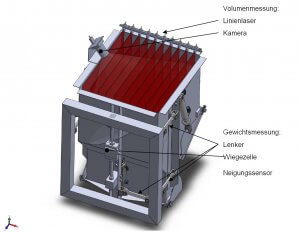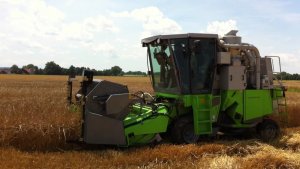Wintersteiger and LCM developed a system that can measure grain during harvesting.

As part of a joint research project with Wintersteiger AG, Linz Center of Mechatronics GmbH (LCM) implemented its own crop measuring method. A physical prototype has been created, which is able to measure the dry density, mass and relative humidity of various cereals during the harvesting process.
The aim of the research project was to develop a new measuring method, which can measure different grain types like barley, rapeseed or maize inside an integrated measuring container. This method operates without restricting the harvesting process.
On the one hand, the benefit of this method is that grain growers know to what extent they should further develop their grain in order to achieve optimum harvest yields. On the other hand, that the farmer can achieve the highest possible crop yield with this seed.
In the course of this research project, extensive knowledge on the subject was acquired. A prototype for trial measurements was also developed.
High requirements
All measuring principles such as mass, moisture and volume should be carried out in a common measuring vessel integrated in a test combine harvester. In addition, the requirement was that measurements should be carried out while driving and the results must not be distorted by the strong vibrations (starting, stopping, rough terrain).
In addition, it had to be clarified which sensor technology is necessary to detect and compensate for these and other disturbing factors such as temperature fluctuations, humidity, dust, etc. The results had to be evaluated and evaluated in order to determine the most suitable sensor technology for the application. Another tricky task was the size and installation height of the measuring vessel on the test combine harvester.
In order for the application to be effective during harvesting, a throughput of up to 5 t of grain per hour was required. Depending on the harvest, masses between 0.5 kg and 30 kg had to be recorded with an accuracy of ±80 g. The throughput of the measuring vessel was determined by the weight of the crop.
Minimum time window to measure harvest efficiently
The mass was measured via a dynamic load cell positioned in the free direction of the measuring vessel with patented suspension (with force and inclination sensor) and a selected 3-axis acceleration sensor. Both Wintersteiger and LCM hold the patent on the suspension. The volume was calculated inside using the shape of the pouring cone according to the light-section method (10 parallel laser lines drawing a grid over the grain, a camera offset by 90 degrees photographed) with an embedded board and optimized algorithms in C++. A specially developed large sensor element was used to capacitively determine the moisture content.
The big challenge was to effectively measure 30 kilograms of grain in a measuring cycle of only six seconds, because the time window is tight with only two seconds for filling, one second for calming, one second for measuring and two seconds for emptying. This made a special design necessary, as the measurement must also function in non-stop operation. It is essential for grain growers that the entire harvest is completed as quickly as possible, otherwise conditions can change.

Applied research at LCM successful
The measurement results were accurate according to the stage of development. However, the required tolerance ranges could only be achieved with combined sensor technology, an optimized mechanical concept, suitable calibration procedures and innovative evaluation algorithms. The targeted accuracy was finally achieved. For grain growers, the measurement of volume and moisture in particular is always a sensitive issue, as the type of grain/type of fruit, the shape of the measuring container, the density of the grain during measurement, the time of measurement and the temperature all have an influence on the measurement process.
The final accuracy of a measurement depends to a large extent on the compensation of interferences. The algorithms developed by LCM can improve these. The specified maximum permissible delay times between the start of the measurement and the display of the result cannot be observed, for example, with conventional methods such as averaging, median filters or similar.
Implemented by LCM
The following parameters were implemented by LCM in the research project:
- Development of the measurement concept taking into account the disturbance and error influencing variables
- Mechanical design of systems (patent applied for by Wintersteiger, patent number: WO002014146152A1; inventor [LCM] Thomas Buchegger, Gerhard Kaineder and [Wintersteiger] Johann Auer)
- Development of electronics (analog circuits, embedded) and software
- Development of signal processing and calibration algorithms
Contact
Dipl.-Wirtsch.-Ing.(FH) Christian Kastl, BSc, christian.kastl@lcm.at, T +43 732 2468-6140
LCM – Linz Center of Mechatronics GmbH | Science Park | Altenberger Strasse 69 | 4040 Linz
www.lcm.at








